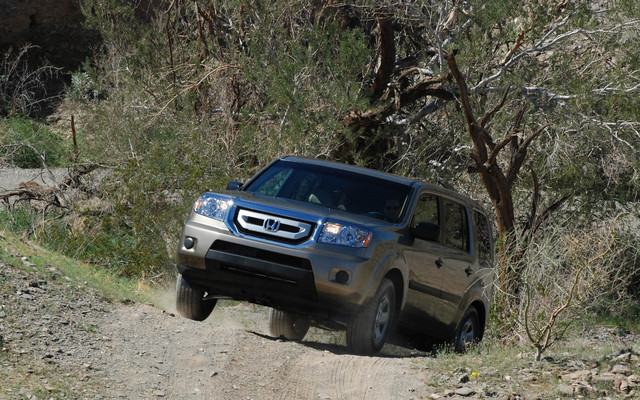2011 Honda Pilot: Leading the SUV Charge
The amount of technology handed down by military applications is downright astonishing. Owing everything from the jet engine to atomic power to the internet to our own violent tendencies, it’s quite ironic to consider that one thing so often associated with suburban life could have come out of the fires of war: the SUV.
No, seriously; think about it for a second. During World War II, the American military commissioned the GPW, which grew into the much-loved civilian Jeep. Simultaneously, the Japanese were using the GPW layout to construct the Toyota Land Cruiser, while the English Land Rover brand actually used a GPW chassis to underpin their prototype’s design. Revolutionizing the way militaries moved men, (and women) and materiel around the battlefield, these rugged enclosed 4x4s spawned some of the most identifiable and longest-lived vehicles in the world today; the Humvee, Defender, Patrol, Land Cruiser, and Geländewagen. Of course, while many of those names can be found within the confines of civilian showrooms, their impact has been much more wide spread than their own sales figures would indicate. Because while those more dedicated models may not be huge sales floor success stories, their less dedicated, suburban-garage-dwelling brethren have been. And one of the vehicles leading this charge of the SUV-lite brigade is this: the Honda Pilot.
Now in its second generation, it doesn’t take long to figure out precisely why this big friendly giant is so popular among the masses. Right from the outset, its boxy, rugged-enough looking shape and a beefy, upright stance retains more of its proud SUV lineage than many of its competitors. In fact, although the previous generation may have closely resembled a supersized CRV, the new Pilot looks downright truck-like by comparison. I for one like the new look, and although the transformation will not impress those that prefer the swoopy lines of Mazda’s big CX9 or GM’s various seven passenger crossovers, the Pilot’s boxier shape does have a silver lining that even swoopy-SUV fans cannot ignore: a massive interior cabin.
Because trust me, this thing’s interior is stretch-out-and-relax, hear-the-echo-of-your-passengers, bottomless-cave big. Although blessed with an upright, commanding seating position that gives a fantastic view of the road, the headliner is miles away from even the tallest passengers’ scalp, while all on board enjoy enough elbow and leg room that doing the funky chicken in every seat is entirely possible. And should you find yourself delegated to cargo-hauling duties, the two rearmost rows of seats fold entirely flat in seconds, allowing yours truly to haul everything from an engine block to a relatively large downhill mountain bike with ease.
And it’s not just the spaciousness that impresses, it’s the quality. Having spent the previous week in the downright atrocious Ridgeline, I was sceptical at first, but the Pilot proved to have none of the vices I so loathed in the Ridgeline. The stupid expanding center console I found in the Ridgeline had been replaced by a massive fixed one complete with roll-top cover, while the dashboard and controls were all hewn from familiarly high-end materials more in line with my expectations. Well styled and intuitively laid-out, the control cluster is exceptionally easy to use and allows easy access to any of the Pilot’s myriad of features. By moving the shifter to its somewhat bizarre location on the dashboard, Honda’s designers have freed up an expansive amount of space for storage while simultaneously making accessing the controls that much easier, as the shifter lays below the majority of the controls when in drive.
And with a downright massive fuel tank, leaving the shifter in drive is something one you can do for hours upon hours at a time. Combine the big SUV’s huge interior cabin with its comfortable driving position and responsive V6, and you get a vehicle than can turn miles into what feels like kilometres, and kilometres into what feels like mere feet. Quiet, and possessing the typical Honda powerband, the peaky 3.5L V6 isn’t what you’d expect from such a large vehicle, but does do well around town; surely the result of well-thought out gearing and a good torque converter. Having little use for the all-wheel drive system during my very dry test period, I would wager the Pilot to be a reasonably sure-footed on most forestry roads, but would stop shy of saying it’s truly off-road capable. On-road, the system maintains a heavy front-wheel drive bias, ensuring maximum fuel economy and predictable handling. Speaking of handling, the Pilot’s soft ride and spongy dampers conspire against any sort of sporting aspirations one may have, but prove a boon on bumpier roads. Also, it’s worth mentioning that the VTM-4 all-wheel drive system did kick in during abrupt manoeuvres, and worked with the stability control program to quell most of the expected understeer.
Overall, it’s exceedingly hard to find fault with Honda’s biggest offering. After seven days imprisoned within the Ridgeline, I had serious doubts as to the wisdom of putting myself through seven more days in its stablemate, but came away with a massive amount of respect for a vehicle I’d often considered to be just another popcorn poseur peddling itself as a proper SUV. Few vehicles have left as much of an impression as the big Honda, and after seven days I was sad to see it go. Opening the door to everything from backroad exploration, to toy hauling, to keeping commuting comfortable, the Pilot did it all in a way few vehicles can hope to match. In short, the Pilot proved itself to be more than capable of fulfilling any task this side of an olive-drab paint scheme, and would be a good choice for doing duty in nearly any Canadian’s driveway.









